
- Androsace koso-poljanskii;
- Schivereckia podolica;
- Alyssum gmelinii;
- Helianthemum nummularium;
- Asperula cynanchica ;
- Centaurea ruthenica/Centaurea ruthenica, family Compositae. It is one of the biggest and most beautiful Centaurea.He has large ornamental green leaves collected in the basal rosette. In late may-early June develop high (up to 1.2 m) strong peduncles, bearing large, up to 8 cm in diameter, fluffy cream inflorescences. In the garden Centaurea grows well in a Sunny place with poor soil, reaching one and a half meters in height, and regularly gives root shoots. To resume the plant, a small piece of root is enough. In August, the seeds ripen. Prunella grandiflora;
Before you the second part of the article Cretaceous Plants in Nature and their Cultivation in the Garden. Let’s continue!
Androsace koso-poljanskii
Androsace koso-poljanskii, family of Primulaceae. This attractive plant is named after the Professor of the faculty of biology, the founder of the Botanical garden in our city.

Androsace is a ground cover plant consisting of a large number of medium-sized (2-3 cm in diameter) rosettes formed by narrow pubescent gray-green leaves. Androsace pillows are 5-25 cm in diameter. In autumn they are reddish, purple, just green, and the size of the sockets vary greatly. It’s hard to believe it’s all the same species. Since the end of summer, the rosettes take the form of rounded small cones: the leaves are lifted and tightly pressed together. Apparently, the plant saves flower buds from the coming cold. In spring, the rosettes turn green and open, in the middle of many buds appear. The pillow becomes loose and higher.
In may Androsace blooms. Its mass flowering, as well as the multicolour of autumn leaf color, also creates the illusion of a variety of forms, and even species Androsace. And no wonder: there are flowers with white color, there is a pink. But the fact is that the flowers Androsace, as well as some primroses, as blooming change color. The buds are at first pale pink, swell and turn white. Just opened flowers-pure white with a greenish-yellow ring in the center. It takes a few days, and this ring turns pink, and then becomes crimson. Flowering lasts about three weeks.
In nature, Androsace grows on chalk scree or on areas covered with a thin layer of soil. Usually it is the South or East side of the hill, that is, a place with intense lighting. The next may grow low perennial herbs or shrubs. Androsace root system is superficial, it penetrates the chalk deep into only 3-4 cm, collecting moisture and minerals from the surface.
To accustom Androsace to the conditions of the garden is difficult. He constantly lacks the sun, so the landing site should be bright and elevated, and the soil – loose, permeable with a lot of chalk. High plants planted in the immediate vicinity, oppress Androsace, although in nature it tolerates the neighborhood of small cereals. Yes, in the garden it can be taken in a light penumbra, on dense oily soil, among weeds, it will even bloom, but in a year or two will inevitably die.
We Androsace grows on a Sunny hill among the limestone rocks, and the soil added chalk brought from his native hill. The plant blooms profusely and ties seeds regularly. Androsace is better to propagate by cuttings of rosettes, rooting them in a light, well-drained chalk substrate and shading from the sun.
Schivereckia podolica
Schivereckia podolica, family Cruciferae. This plant is now less common in nature. We have traveled almost all mentioned in the reports of Botanical expeditions, where it was found in the 40-50-ies, and found it only in two.

In the first of them, on the slope of a low hill among Androsace was found only a few tiny plants: small bluish, like wax, rosettes and white, similar to Arabis, flowers in medium-sized umbrellas (1.5 cm in diameter) on thin peduncles, and the entire height of the plant – 7 cm.Another place was a large gentle hill with a fairly developed soil layer. There among the low grasses there were a lot of Schivereckia, and she was older and bigger. But, unfortunately, this hill is near the village and is used, judging by the numerous traces, as a place of grazing, so whether Schivereckia will remain there is unknown.
Schivereckia is neither the brightness nor the aroma, but there is in it some poignancy. This is one of the plants on the verge of extinction, and maybe this sad circumstance and gives it a special charm. In addition, Schivereckia early (early April) blooms and blooms for several weeks. She has attractive rosettes of gray leaves, and she would look good on a small Alpine slides.
Taken from nature, Schivereckia takes root with difficulty, but it is easy to grow from seed, although the results of sowing may be unexpected, as it happened with us. I do not know whether the seeds we received were collected from a cultivated plant or taken in nature. They sprouted well, and the next year in early April, our Schivereckia bloomed, but its appearance somehow did not match the descriptions-like, then, but not quite. That’s why we went to look for her on the chalk hills.
Having brought two small Schivereckia home, comparing them to ours, we realized that we were not deceived. Just fertile soil has greatly changed the appearance of the plant. The leaves of our Schivereckia were twice as large, the rosettes no longer pressed to the ground, but lifted, losing the shape of a wax rosette, the peduncles were numerous, and the white inflorescences closed, forming a large cap, which was not observed in nature. And in the distance, and near our Schivereckia resembled Arabis losing its charm and small size, peculiar to the wild plant. But the obvious advantages were early flowering and, as time has shown, the rarest stability in the culture.
Alyssum gmelinii
Alyssum gmelinii, family of Cruciferae. This shrub with lignified stem and prostrate shoots, covered with wintering small gray-green, decorative leaves, often found on Cretaceous scree.
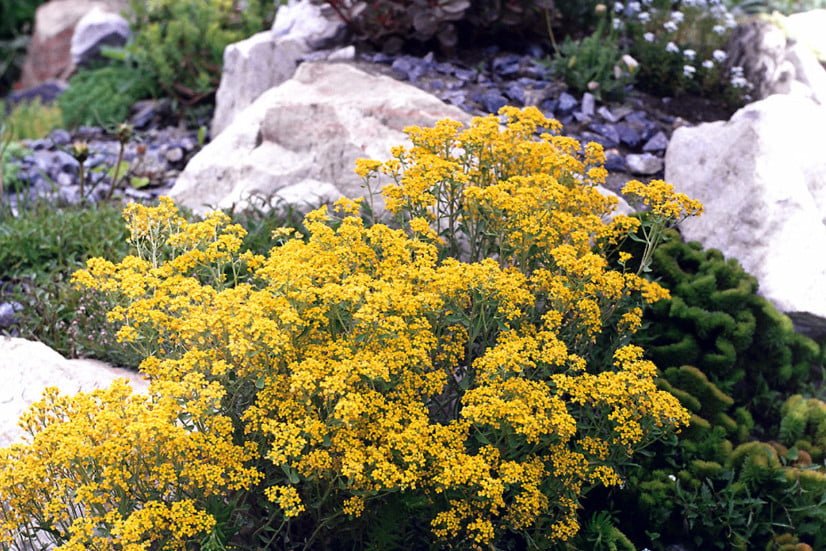
It blooms in early may. Small lemon-yellow flowers are collected in short brushes at the end of the stems. The plant takes root well in the garden, without changing its natural appearance. It is picky to the soil, the main thing-a sufficient amount of light. Propagated by seeds alyssum, sometimes it gives self-seeding.
Helianthemum nummularium
Nummularium Helianthemum, family Cistaceae. Evergreen shrub, which is also often found on the Cretaceous hills. It is similar to its many hybrid forms, but below and less grows in breadth, and the flowers it are only yellow. They appear from June to August, opening in the morning and showering for dinner.
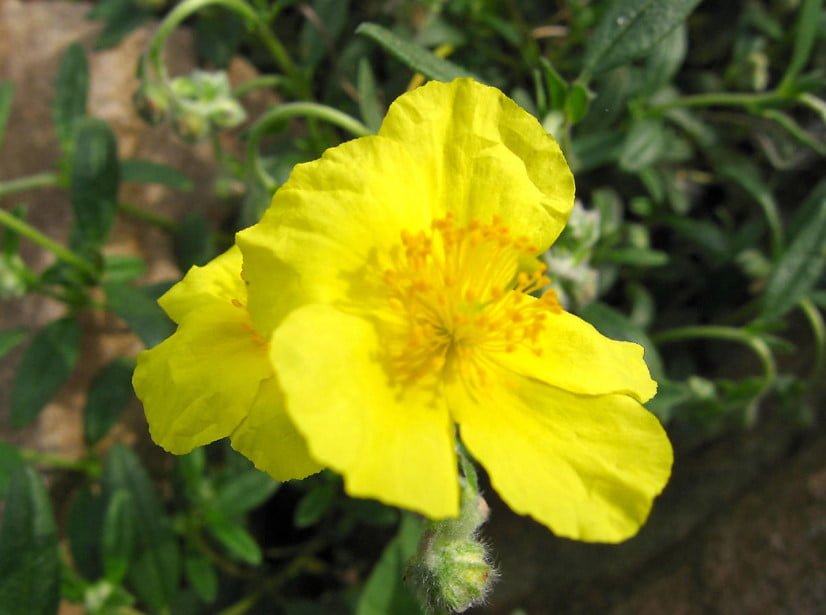
Less common Helianthemum canum with small, grayish pubescent leaves and small (about 1.5 cm in diameter) lemon-yellow flowers.
In the garden, all Helianthemum take root well, preferring light, permeable soil, and even withstand weak shading. Propagated by seeds and cuttings.
Asperula cynanchica
Asperula cynanchica, the Rubiaceae family. Asperula mostly adjacent to Androsace and not just adjacent, and closely intertwined their stems with his pillows, vrasta in them. In the South, the Androsace area is gone, and the Asperula grows one, forming charming tiny hemispherical pads, 7-10 cm in diameter.

They live in pure chalk, in the bright sun, with almost no neighbors. Dark needle-shaped foliage, forming whorls, tightly covers short stems (5-7 cm tall). In early June, at the end of the stems appear pink or white blossoms small waxy flowers with four-lobed limb.
In culture, Asperula needs light soils with lots of chalk and bright light. Another important condition is the absence of neighbors. The plant can take root on dense fertile soils among the thickets of other flowers, but in such conditions it is stretched, pales and dies the next year. Even in an open, Sunny place, in the soil with a lot of chalk plant is stretched in two or three times, green, and the flowers lose their beautiful pale pink color and become white. In culture, this plant is good ties seeds.
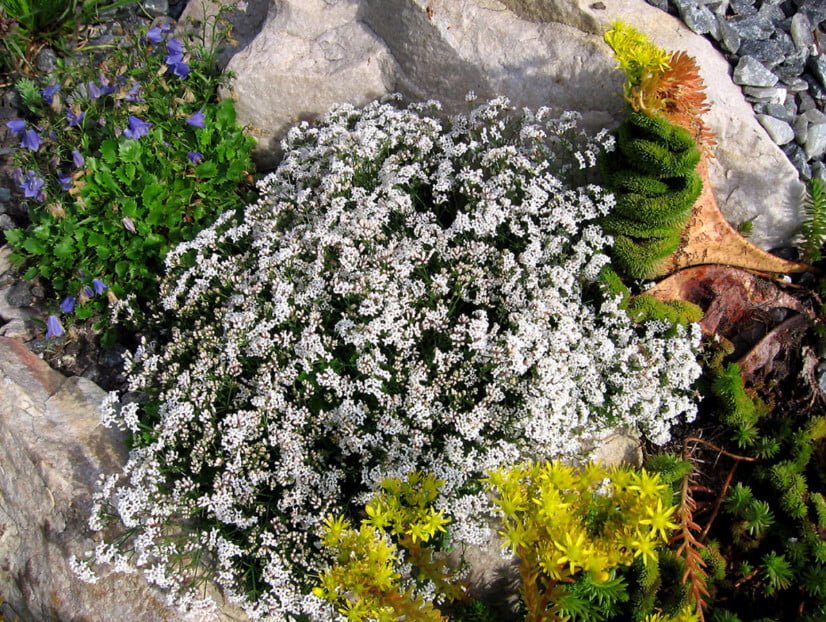
Two years later, Asperula on our hill has grown, forming a pillow about 40 cm in diameter, in June, completely covered with white flowers with a pinkish tinge. Such abundant flowering and pillow sizes are not found in nature. Taking the entire allotted him a small veranda, our Asperula got to the neighbors and was slow to get rid of.
Centaurea ruthenica/
Centaurea ruthenica, family Compositae. It is one of the biggest and most beautiful Centaurea.

He has large ornamental green leaves collected in the basal rosette. In late may-early June develop high (up to 1.2 m) strong peduncles, bearing large, up to 8 cm in diameter, fluffy cream inflorescences. In the garden Centaurea grows well in a Sunny place with poor soil, reaching one and a half meters in height, and regularly gives root shoots. To resume the plant, a small piece of root is enough. In August, the seeds ripen.
Prunella grandiflora
Prunella grandiflora, of the family Lamiaceae. Grows in the grass on the chalk hills. From it there are varieties, but wild Prunella attracts attention with bright flowers. In nature, it forms a small sod of dark green leaves. Bright purple flowers are collected in short brushes. The garden feels great. Can form a whole thicket, delighting all summer catchy flowering. Well propagated by division and seeds.
My garden has taken root and many other wild plants of the Cretaceous. Growing them and reproducing them has become a fascinating business for me, which I continue. I hope that some of the readers of my experience will be useful.
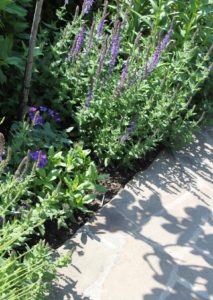
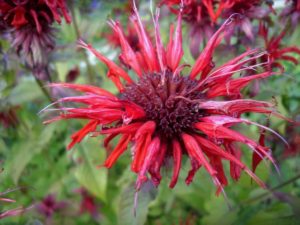
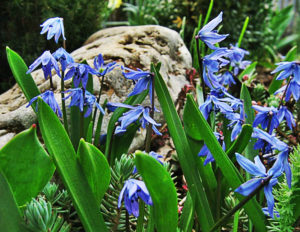

Leave a Reply